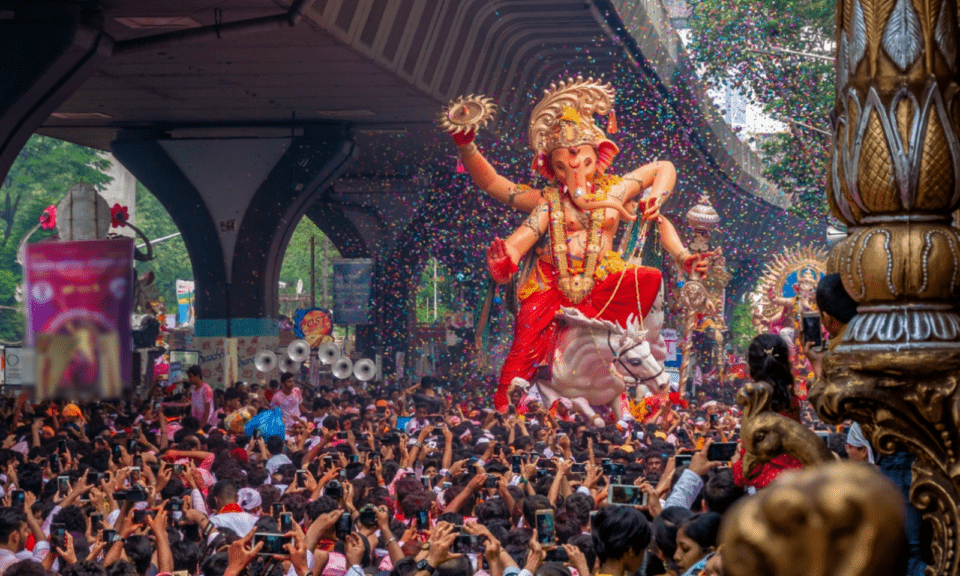Ganesh Chaturthi, celebrated with unwavering fervor and enthusiasm throughout the country, serves as a symbol of the warm welcome accorded to Lord Ganpati into our homes and hearts. It was Bal Gangadhar Tilak who planted the seeds of Sarvajanik Ganesh Utsav, a celebration that transcended boundaries, uniting people from diverse backgrounds. During the visarjan (immersion) process, the rhythmic drumbeats resonated, and everyone danced with unbridled joy, transcending the barriers of religion, caste, or gender.
In a country where, even today, people often find themselves embroiled in disputes over religion and the importance of festivals, it’s vital to harken back to a time during the independence era when visionary leaders like Bal Gangadhar Tilak used festivals as a powerful means to bring the nation together.
**How Things Took a Turn in 1857**
The year 1857 is etched in history for the Indian Rebellion, known by several names such as the Sepoy Mutiny, India’s First War of Independence, and the Revolt of 1857. It was a rebellion that posed a serious threat to the dominance of the East India Company. Bal Gangadhar Tilak emerged as one of the prominent leaders during this Great Rebellion. He recognized the dire need to unite Indians and realized that nothing could bond people more profoundly than a common idol revered equally by all.
Tilak astutely observed that Lord Ganesh was considered “the God for everyman,” worshipped by members of both upper and lower castes, leaders, and commoners alike. He championed Ganesh Chaturthi as a national festival with the intent to bridge the gap between the Brahmins and the non-Brahmins. Lokmanya Bal Gangadhar Tilak initiated the public celebration of the Ganesh festival in 1893, aiming to bring people of all religions together on a shared platform in India’s quest for freedom.
In 1893, the Indian independence struggle was at its zenith. Bal Gangadhar Tilak yearned for Swaraj (self-rule) and societal transformation, aiming to unite all patriotic forces through a grand public event. To foster stronger bonds at the grassroots level, he decided to appeal to people through their deeply rooted religious sentiments. This decision led to the revival of the Ganesh Chaturthi celebration.
Tilak metamorphosed Ganesh Chaturthi into a mass celebration. He initially used this platform to ignite the flame of patriotism in Pune, where it received an overwhelmingly positive response.
Continuing his tireless efforts, Tilak extended the mass celebration, known as Sarvajanik Ganeshotsav, to Belagavi. With the invaluable support of freedom fighters Govindrao Yalgi and Gangadhar Rao Deshpande, who were spearheading the freedom struggle in the Belagavi region, he orchestrated a grand celebration in Belagavi. The first Sarvajanik Ganesha idol found its place in Govindrao Yalgi’s residence.
In 1893, Tilak organized Ganesh Utsav as a social and religious event. He displayed large hoardings featuring images of Lord Ganesh in pavilions and was the driving force behind the tradition of immersing colossal Ganesh statues on the festival’s tenth day. The festival served as a meeting ground for people of all castes and communities during a time when public social and political gatherings were prohibited by the British.
In 1905, Tilak paid a visit to Belagavi and marked the inception of the first bamboo pole for the pandal of Sarvajanik Ganeshotsav. During this time, the first Sarvajanik Ganeshotsav Mandal was formed in Belagavi at Zenda Chowk, which is now known as Madhyavarthi Sarvajanik Shri Ganapathi Utsav Mandal. Subsequently, five more mandals (groups) were established, making Belagavi a focal point for Ganesh Chaturthi celebrations even before Mumbai embraced the tradition. The tradition of mass celebration of Ganesh Chaturthi endured even after India attained independence.
Furthermore, this festival evolved into a congregation of ordinary people from various castes and tribes. It gradually assumed both religious and social significance. Nationalistic speeches and cultural programs became integral parts of the festivities. Notably, even prominent Muslim figures addressed these annual events, urging their fellow citizens to strive for independence.
Whether it’s relishing modak during Ganesh Utsav or savoring sheer kurma during Eid, people cherish these moments by sharing their festivities with brethren from diverse religious backgrounds. Festivals and gods themselves do not discriminate among religions; it is us, humans, particularly those in positions of power, who have regrettably sown divisions among us.
Bal Gangadhar Tilak’s vision of employing festivals to bridge divides and unite the nation remains profoundly relevant today. In an era where religious and cultural differences sometimes lead to discord, his legacy serves as a poignant reminder that festivals possess the power to foster unity, spread joy, and celebrate the diversity that makes India an extraordinarily unique nation. Ganesh Utsav, with its rich history and enduring traditions, stands as a testament to Tilak’s enduring impact on the fabric of Indian society.
As an independent media platform, we do not take advertisements from governments and corporate houses. It is you, our readers, who have supported us on our journey to do honest and unbiased journalism. Please contribute, so that we can continue to do the same in future.

